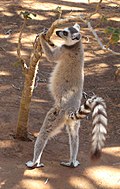Wikipedia:Today's featured article
|
Today's featured article Each day, a summary (roughly 975 characters long) of one of Wikipedia's featured articles (FAs) appears at the top of the Main Page as Today's Featured Article (TFA). The Main Page is viewed about 4.7 million times daily. TFAs are scheduled by the TFA coordinators: Wehwalt, Gog the Mild and SchroCat. WP:TFAA displays the current month, with easy navigation to other months. If you notice an error in an upcoming TFA summary, please feel free to fix it yourself; if the mistake is in today's or tomorrow's summary, please leave a message at WP:ERRORS so an administrator can fix it. Articles can be nominated for TFA at the TFA requests page, and articles with a date connection within the next year can be suggested at the TFA pending page. Feel free to bring questions and comments to the TFA talk page, and you can ping all the TFA coordinators by adding " |
Featured article candidates (FAC): Featured article review (FAR): Today's featured article (TFA):
Featured article tools: |
From today's featured article
The Legend of Zelda: Majora's Mask is a 2000 action-adventure game developed and published by Nintendo for the Nintendo 64. It makes use of enhanced 3D graphics and features several gameplay changes, but reuses elements and character models from Ocarina of Time (1998). It follows Link, who arrives in a parallel world, Termina, and becomes embroiled in a quest to prevent the moon from crashing in three days' time. The game introduces gameplay concepts revolving around a perpetually repeating three-day cycle and the use of various masks that transform Link into different forms, and requires the Expansion Pak add-on for the Nintendo 64, which provides additional memory for more refined graphics. Majora's Mask was acclaimed by critics, and generated a cult following. It was rereleased for the GameCube in 2003, and for the online services of the Wii, Wii U, and Nintendo Switch. An enhanced remake for the Nintendo 3DS was released in 2015. (Full article...)
From tomorrow's featured article
Lemurs of Madagascar is a 2010 reference work and field guide on the lemurs of Madagascar, giving descriptions and biogeographic data for the known species. The primary contributor is Russell Mittermeier, president of Conservation International, and the cover art and illustrations are by Stephen D. Nash. Currently in its third edition, the book provides details about all known lemur species, general information about lemurs and their history, and tips for identifying species. Four related pocket field guides have also been released, containing color illustrations of each species, miniature range maps, and species checklists. The first edition was reviewed favorably. The first edition identified 50 lemur species and subspecies, increased to 71 in the second edition and 101 in the third. The taxonomy promoted by these books has been questioned by researchers, such as Ian Tattersall, who view these growing numbers of lemur species as insufficiently justified inflation of species numbers. (Full article...)
From the day after tomorrow's featured article
The Portland spy ring was an espionage group active in the United Kingdom between 1953 and 1961. It comprised five people who obtained classified research documents from the Admiralty Underwater Weapons Establishment (AUWE) on the Isle of Portland, Dorset, and passed them to the Soviet Union. Two of the group, Harry Houghton and Ethel Gee worked at the AUWE and had access to classified information. They passed this to their handler, Konon Molody (pictured), a KGB agent acting under a Canadian passport in the name Gordon Lonsdale. Lonsdale would pass the documents to Lona and Morris Cohen, American communists living under the names Helen and Peter Kroger; they passed the information to Moscow. The ring was exposed in 1960 after a tip-off from the Polish spy Michael Goleniewski. The information he supplied was enough to identify Houghton. MI5 surveillance uncovered the rest of the group, who were arrested in January 1961 and tried that March. Sentences for the group ranged from 15 to 25 years. (Full article...)




